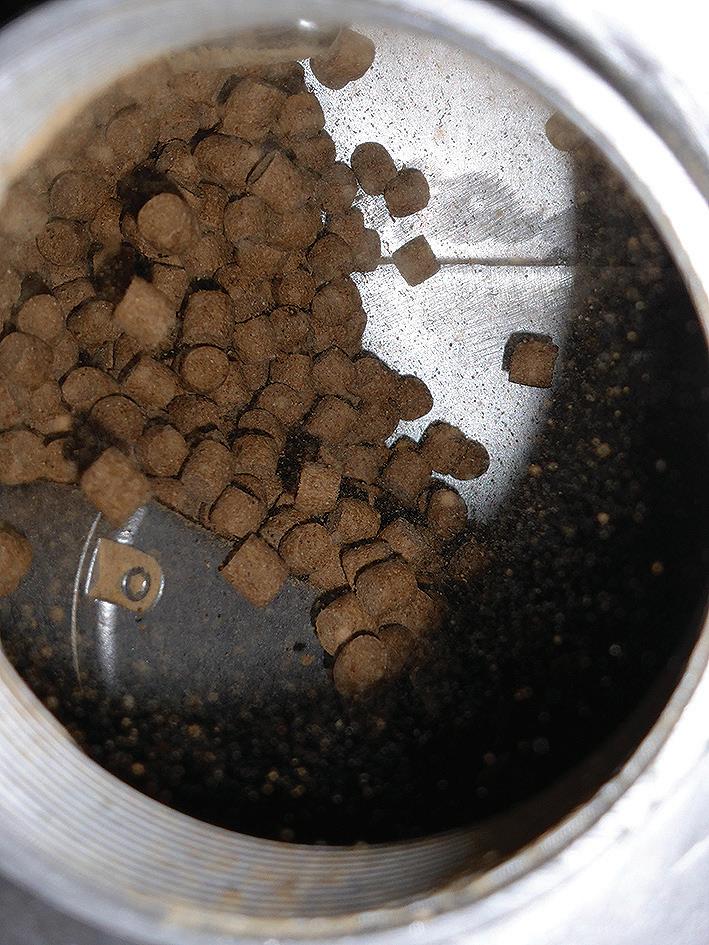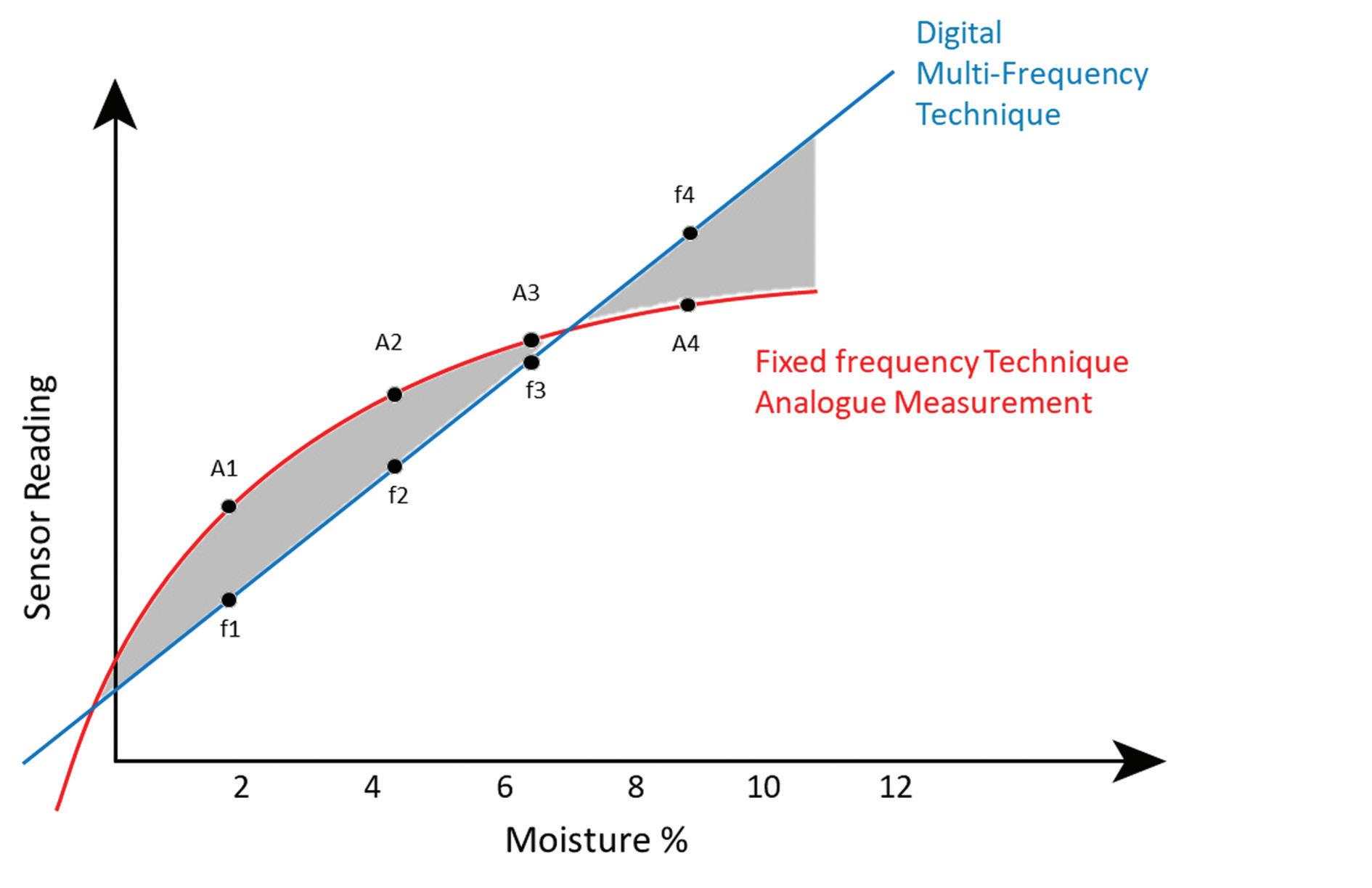
6 minute read
Water underwater?
Alessandro Mario, Hydronix
Fish feed has multiple forms and a wide variety of formulations with different ingredients. In the process, ingredients go through similar steps, including storage, milling, drying, conditioning and pelletizing.
Imagine that it would be possible to improve the protein ratio and the profitability in your processes, while saving energy, reducing waste and carbon footprint. Sure, it would be a dream but is it possible? Let us analyze the processes to see where we can find a solution.
Storage
The ingredients must be stored and preserved correctly to prevent mycotoxins, spoilage, or heat spots. These often give problems that are directly related to the moisture contents and so monitoring water content while transferring into storage is important to be able to react to problems.
Drying
Drying is a common practice to store materials safely, and it is a delicate process to reach the perfect moisture target. If you miss the target, the ingredients are prone to mycotoxins and spoilage. On the other hand, over-drying is not just an expensive waste of energy but can cause damage, shrinkage and loss of yield.
The material entering the drier has variable water content, and this makes it challenging to regulate the amount of time the material needs to be exposed to the heat or to regulate the temperature.
In this process, inline moisture control is used to automate the dryer to save money and improve quality.
Conditioning
After drying, depending on the material and system requirements, it may be necessary to reintroduce moisture into the product by conditioning. This can be done before milling or pelleting operations. Depending on the final application, the conditioning
Figure1. Moisture control affects the cost and quality of feed products.
can also heat the material to kill germs, cook ingredients and gelatinate starch.
In the same way that moisture control enhances the drying phase, it also improves the conditioning process by reacting quickly to changes in the input material moisture.
Grinding
Grinding is one of the most energy-consuming transformations in many food processes. Through mechanical action, it reduces the size of feed materials such as grain, seed, fruit and many more to achieve different chemical and microbiological stability.
Results vary based on machines and methods used, as well as toughness and moisture of the material processed. The toughness is the ability of a material to resist breakage. Therefore, tougher material will need more mechanical energy to reduce size.
The plasticity or ductility of a material determines the amount of energy absorbed before breaking down as well as the final size. More plastic or ductile material will need more energy to break, but it will maintain a more regular final shape. In contrast, less plastic or ductile material will shatter into finer and irregular shards like particles.
Table 1. Moisture technologies available in the market.
Type of Technology Maintenance
NIR/Infrared
High
s
Resistive Capacitive
Medium Medium
Microwave Analogue Hydronix Digital Nuclear
Medium
Very low
t t Very Highs s
Temp
l
l
l
l
Salts
l
l
l
Density
l
l
l
l
Dust
l
Colour
l
Note
Surface reading Unreliable Unreliable Unreliable Flowing materials Only huge quantity
The water content affects the elasticity of the material. Therefore, by controlling the moisture of the material, it is possible to determine the energy consumption of the process, the final size of the powder particles, and the product yield and loss.
For these reasons, the initial moisture of many feed materials is the most important element to regulate before the grinding process.
Pelletizing
Pelletizing is the process of extruding the formulation into cylindric shapes that are more easily consumed by the fish. The content of the mix is extremely variable between the various applications and formulations. However, even in this process, water content is still an important factor to measure the quality of pellets.
Drying pellets
The final drying is essential to ensure the pellet shelflife and quality. As explained before, drying is a delicate procedure where it is important to achieve a specific water content, and inline moisture control will help you adjust to the variation in the material.
Control and sensors
In summary, the moisture affects the costs and the quality of the products. Knowing and subsequently controlling the water content of the material in every step of the process is necessary to improve efficiency, reduce carbon footprint and save money. By controlling the moisture during the process, it is possible to calculate the protein content of the pellet and guarantee superior product quality.
To achieve these results, sampling the material is not enough because the samples may not be representative of the full batch, and the speed of the feedback process is not adequate. It is possible to achieve real-time control in the process with inline sensors.
The solution is simple, as using an online sensor makes it possible to know the moisture in the material (Fig. 1). Measuring the water content is an indirect measurement, meaning that it is calculated from another measured property, so to do this accurately, other factors need to be kept as constant as possible: • Material composition • Particles size • Pressure on the sensor • Flow speed • Position of the sensor For this reason, it is key to calibrate the moisture sensors for each material after the final system installation. The calibration must be realized by accurate lab tests, as calibrating any sensor with another different sensor can cause a sum of errors resulting in incorrect calibrations, defeating the objective completely.
Independently from the measurement method used in the process, it is critical to completely remove moisture from the sample to reach the dry weight during the lab test, as this is what will be used while calibrating the sensor to define the moisture reported by the sensor.

But are all sensors equal?
There are many moisture sensors available on the market, and these different technologies can be
Figure 2. Linearity and stability of moisture measurement.
summarized in the five categories in Table 1.
An essential but often overlooked difference in the digital microwave technology is the linearity and stability of the measurement. Resistive, capacitive and analogue microwave sensors have a nonlinear measurement making them very difficult to calibrate as they require numerous points to design the curve. Nonlinearity also implies low accuracy at the wet and dry end of the scale (Fig. 2).
Sensors with a digital measurement technique have a linear measurement, meaning that the sensor reading and water content are directly and proportionally related. This method allows systems to achieve optimal calibration with a few points. In theory with a linear system, it is possible to achieve calibration with only two points.
After these considerations, it is possible to define the ideal requirements of the moisture sensor: • In-line with multiple readings per second, providing quick feedback for the control to adjust every batch. • Robust, made with high-quality materials to withstand tough industry conditions. • Linear measurement, repeatable and stable over time, precise in every condition and simple to calibrate to enable an accurate output. • Store multiple calibrations to be used with different materials. • Ability to measure into the flow of the material. • Unaffected by dust, color, or variations in salt and mineral content. • Self-contained and easy to integrate into existing systems. • Low maintenance and cost-effective. • Able to monitor and configure remotely for flexible connectivity and analysis. Thanks to the expert research and development team at Hydronix, all the above characteristics can be found in Hydronix microwave sensors which incorporate a unique digital microwave technology made to last in the harshest conditions.
Hydronix is driven by the belief that by helping you succeed, we help to build a more sustainable future for our children and the generations to come. For these reasons, Hydronix, with its 39 years of passion and expertise, provides the best digital microwave moisture sensor technology. Hydronix is present in over 80 countries around the globe, providing a network of expert engineers on the field speaking your language.

More information: Alessandro Mario
Technical Sales Engineer Hydronix Ltd., UK E: enquiries@hydronix.com








